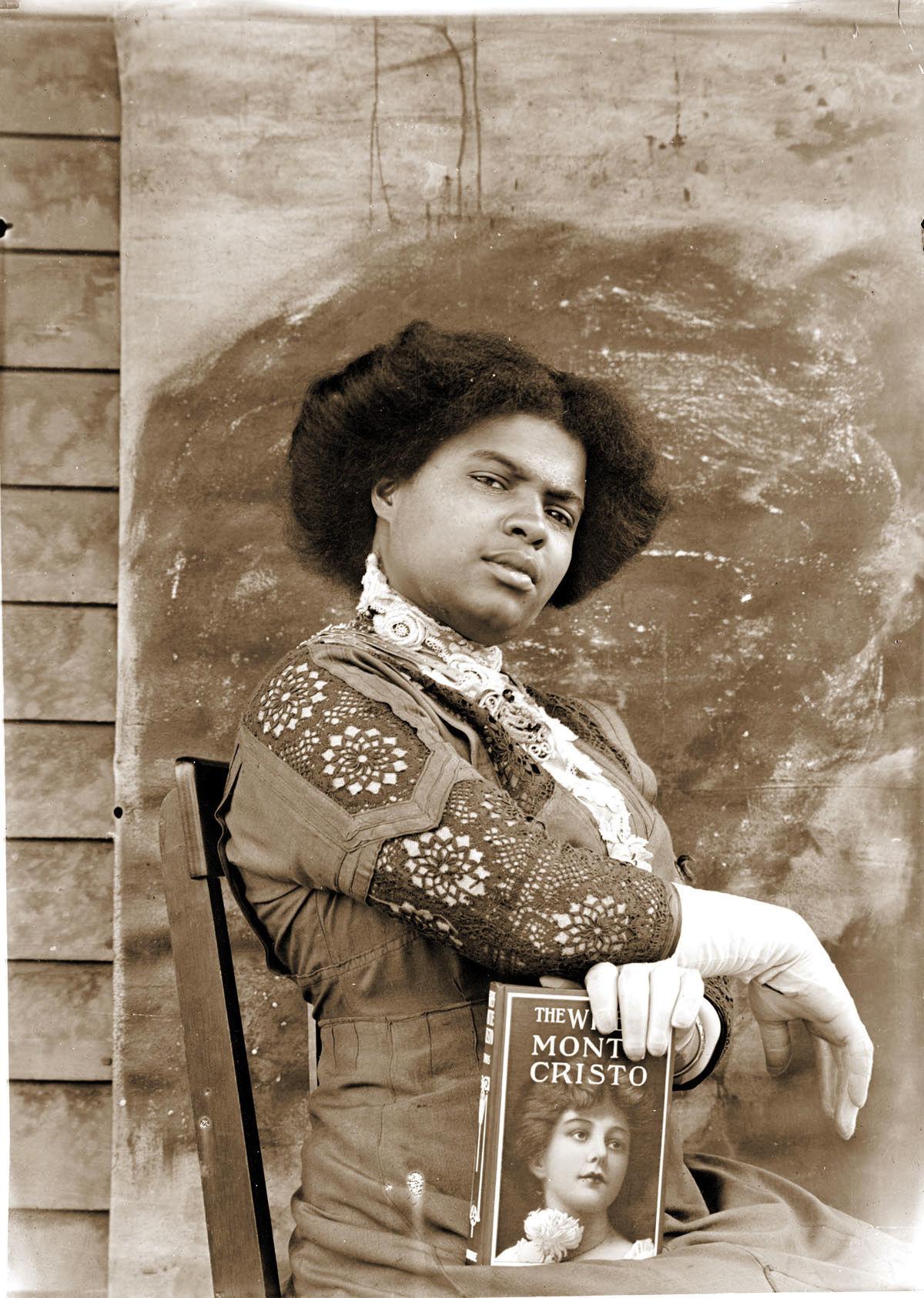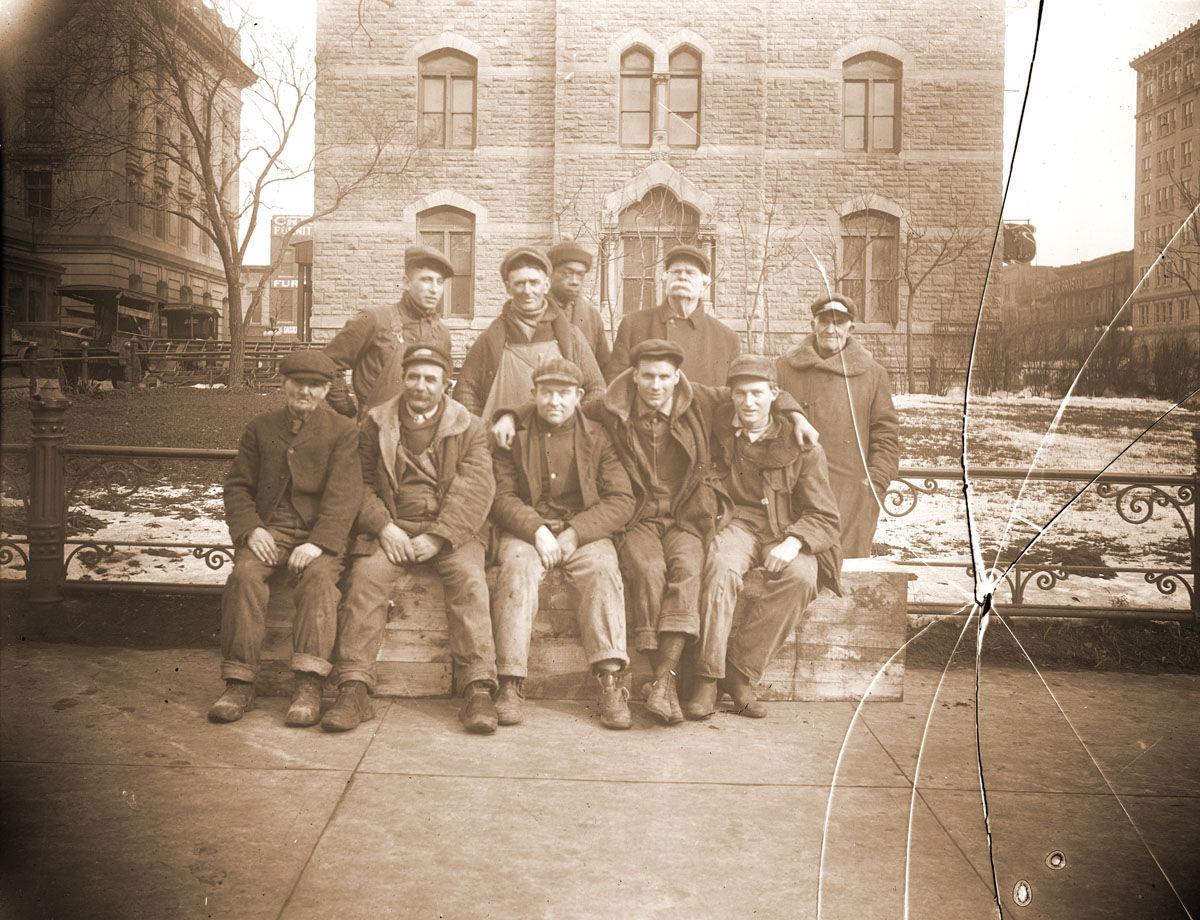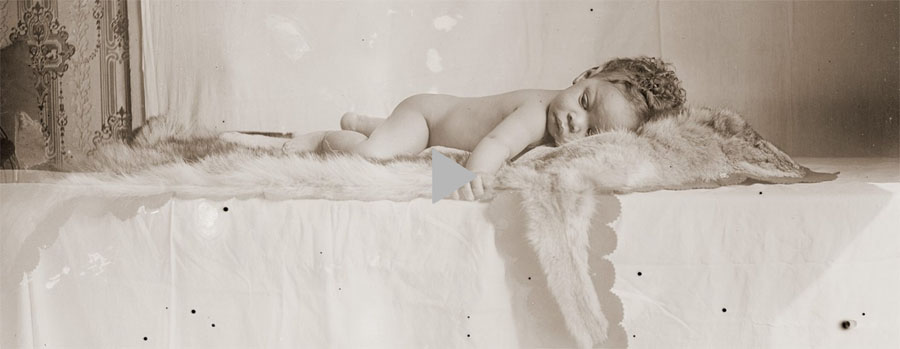By Doug Boilesen, 2014
The following Lincoln Journal
Star newspaper article was written by Nancy Hicks in 2013
and is a good summary of John Johnson's photographs that he
took in Lincoln, Nebraska between 1910 and 1925 and how some
of Johnson's glass negatives ended up as photographs in the
National Museum of African American History and Culture in Washington,
D.C.
Axel Boilesen and his son Doug
originally obtained these glass negatives after placing an ad
in the Lincoln Journal Star and receiving a call that
took them to a house that had some phonograph related items.
The following story is included with Axel's Friends of the
Phonograph stories because Axel and Doug purchased these
glass negatives, 'transferred' them to neighbor and friend Doug
Keister (a.k.a. DK) while retaining only one glass negative
with the Edison phonograph and little girl in it. DK's friendship
would be maintained through the decades and his caretaking of
those negatives and efforts to promote the legacy of John Johnson
are described in the following 2013 newspaper article.

This little girl
stands proudly for her portrait next to an Edison C-150 Sheraton
design phonograph. This Edison disc phonograph 'was introduced
in June 1915 and manufactured until 1918. It was a very popular
model and became Edison's second-best seller in 1917."
(1) The photograph was
taken by John Johnson in Lincoln, Nebraska circa 1920.
Century-old pictures of black
Lincolnites to hang in new national museum
August 05, 2013 4:00 am • By NANCY
HICKS / Lincoln Journal Star
This story of discovery began
with an article in the Lincoln Journal Star about 36
stunning photographs.
And it ends with the likelihood
that pictures of Lincoln residents from the early 1900s -- black
Lincolnites featured in the work of a black photographer --
will hang in the new National Museum of African American History
and Culture in Washington.
“It’s one of those 'Antiques Road
Show' kind of stories. Even better,” said Doug Keister, a Lincoln
Southeast graduate who, for decades, saved heavy boxes of glass
negatives he bought in Lincoln as a teenager.
They turned out be an artistic
and historic treasure.
In May 1999, former Journal Star
reporter Clarence Mabin wrote a story about 36 glass negatives,
beautiful photographs of Lincoln’s black community in the early
1900s, taken by an unknown photographer.
“I was expecting some amateur
work, and these pictures just knocked me for a loop. So well
proportioned, such a brilliant use of space and sense of composition,
such amazing rapport with his subjects," John Carter, historian
for the Nebraska Historical Society, said in that story.
"It’s obvious he’s doing more
than just taking a picture. He’s doing portraiture. And social
commentary.”
Mabin’s article led to the discovery
of Keister’s collection of several hundred pictures, taken in
Lincoln roughly between 1910 and 1925 by photographer John Johnson.
Keister, a photographer, author
and Lincoln native, has donated 60 large-scale prints made from
that collection to the new museum, due to open on the National
Mall in 2015.
“They speak to a time and a place
where African Americans were treated as second-class citizens
but lived their lives with dignity,” museum curator Michele
Gates Moresi said about the exhibition in an article in the
February 2013 Smithsonian Magazine.
For decades, the photos were simply
a heavy load that Keister carted from house to house, taking
up valuable storage space.
Keister got the glass negatives
from friend Doug
Boilesen and his father, Axel, who bought the negatives
from a Lincoln family during their search for antiques, including
an Edison phonograph, the “holy grail of phonographs,” Keister
said.
One of the negatives was of
a girl standing beside an Edison phonograph.
Keister bought the boxes for $15.
Keister printed some of the negatives
-- O Street, construction of the Miller & Paine building and
the post office (now the Grand Manse) -- and sold them to local
history buffs like Jim McKee, years before anyone recognized
the value of the entire collection.
And Keister took the boxes with
him when he moved to California, continuing to cart them around
the state as he moved.
In 1999, Keister’s mother, Kay
Keister, clipped and sent the Journal Star story about the 36
negatives to her son. She remembered he also had some glass
negatives, so she thought he might be interested.
Keister realized his were likely
the work of the same photographer.
He brought his boxes, containing
almost 280 glass plates, back to his hometown and met with Lincoln
historian Ed Zimmer.
Since then Zimmer, a historical
sleuth, has identified the photographer, put names to some of
the faces and Lincoln locations, and found more negatives and
pictures, 400 to 500 of them: the Keister collection plus others,
many saved by descendants of those photographed.
History Professor Jennifer Hildebrand
has used the pictures as examples for an article on the New
Negro Movement, a precursor to the Harlem Renaissance.
In an era when black Americans
faced severe discrimination, "new Negroes evinced pride in self,
in their African heritage, and in the color of their skin. Often
the images that they shaped convey a great sense of confidence,
strength and determination," Hildebrand, an associate professor
of history at the State University of New York, Fredonia, wrote
in a 2010 Nebraska History Quarterly.
"The beauty of the black race
and the shared goals and aspirations of white and black Americans
were at the heart of the NNM," she wrote.
The 36 plates that were the focus
of Mabin's story were discovered as University of Nebraska-Lincoln
graduate student Kathryn Colwell was researching historic black
landmarks in the city and interning with Zimmer.
Ed Wimes, now an executive vice
president at UNL, told her about the plates, owned by the McWilliams
family, information she passed on to the Historical Society's
Carter.
Carter went to the home of Victor
and Juanita McWilliams to see the negatives.
They were in a Harley-Davidson
boot box, he remembers, the negatives carefully separated by
kitchen towels.
Carter picked up the first one,
he said: "And it wasn’t a good photograph, it was a phenomenal
photograph. The hair stood up on the back of my neck.
"I picked up the next one --
and next one -- all were just phenomenal."
Mabin, who now works in the Legislature’s
performance audit office, had seen prints of some of the pictures
when he interviewed Art McWilliams Sr. in 1989 for a story about
the McWilliams family's long history in Lincoln. He remembers
instinctively knowing that they were extraordinary pictures.
The photographer, Zimmer concluded,
was John (Johnny) B. Johnson, an 1899 graduate of Lincoln High
School who briefly attended the University of Nebraska, where
he played football.
In an era when black Americans
were not hired by white businesses for anything other than menial
labor, Johnson was a janitor at the federal building, drove
a wagon and photographed Lincoln's small black community.
Johnson was born in 1879 to Harrison,
a Civil War veteran, and Margaret Johnson, both former slaves.
He married late and lived most of his life in a home built by
his father at 1310 A St.
Some of the photos appear to be
commissioned portraits. Others feature co-workers, family and
friends. And some show Lincoln architecture, construction sites
and the men who worked there.
Some are elegant portraits, with
the families of Lincoln's black leaders at the time -- the McWilliamses,
Malones, Deans, Talberts, Burckhardts, Williamses -- among the
subjects.
In addition to their beauty, the
photos have historical significance because there are so few
photographs from the era depicting African Americans in small-
and medium-size towns taken by a black photographer.
Keister calls them a “rare glimpse
into the everyday lives of an African-American community on
the Great Plains.”

The young lady on the right
is Florence Jones (later Clark). Her companion has not been
identified. Jones was a student at Park and McKinley elementary
schools and Lincoln High School, graduating in 1923. The photograph
is among many taken in Lincoln on black and white glass negatives
by African-American photographers John Johnson and Earl McWilliams
between 1910 and 1925. 2001 Backyard picnic Mother's touch Baseball
player Florence Jones and companion

This photograph was taken on
the front porch of a house that still stands at 715 C St. in
Lincoln. At the time Cora and Alonzo Thomas ran a grocery store
in the front room of the home. Four of the Thomas children and
two friends are in the photo. The baby is Lonnie Thomas, born
in 1909, who became a championship golfer. Lonnie’s daughter
Deborah Thomas was a backup singer for several groups including
Lionel Richie and Diana Ross. The little white girl at the side
is Marie Busch, who lived next door at 703 C St., the daughter
of Germans from Russia immigrants. JOHN JOHNSON, Courtesy
Douglas Keister

Mamie Griffin, who worked as
a cook, lived at 915 U St. in 1914 with her husband, Edward,
a waiter at the Lincoln Hotel. Their little house and other
humble residences stood on a dirt street among railroad tracks
and industrial uses north of downtown Lincoln. Far from humble
are the dress and demeanor of this woman, posing confidently
with her romance novel, "The Wife of Monte Cristo." JOHN JOHNSON,
Courtesy Douglas Keister

Two women show off their pit
bull terrier, circa 1910-25. JOHN JOHNSON, Courtesy Douglas
Keister

In this photo by John Johnson
of Lincoln, 10 people and a dog share in a backyard picnic,
circa 1910-25. The scene appears casual, but the picnic benches
have been angled out from the table to allow each person to
be seen, and to lead the eye to the couple serving as host and
hostess. Johnson documented African-American life in Lincoln
in the early 20th century. JOHN JOHNSON, Courtesy Douglas
Keister

After this John Johnson photograph
was featured in Newsweek magazine in November 1999, collection
owner Douglas Keister received a call from a radiologist in
Atlanta, Ga. The man, Jim Zakem, said the child on the far left
was his father, James. Zakem's grandfather, Lebanese-born Alexander
K. Zakem (1879-1942), and his wife Anise had three children.
James, born in Michigan in 1917, is pictured at left beside
little sister Lillian. The blond boy was a playmate. Older sister
Adeline (at right) was born in Montreal in 1916. JOHN JOHNSON,
Courtesy Douglas Keister

Manitoba "Toby" James had three
daughters and two sons. Pictured with him here are his firstborn
son, Mauranee (in the hat at right), and his daughters Myrtha
(left) and Edna (center). JOHN JOHNSON, Courtesy Douglas
Keister

This scan of a glass plate
negative by photographer John Johnson shows early Lincoln history.
JOHN JOHNSON, Courtesy Douglas Keister

The address on the house behind
these well-appointed gentlemen suggests it was the home of George
and Fronia Butcher at 2001 U St. Butcher (thought to be the
taller man) was born in Philadelphia in 1874, and died at the
VA Hospital in Lincoln in 1958. He worked for the Chicago &
Rock Island Railroad as a porter and for Burlington as a laborer
in the Havelock Shops. Fronia Butcher was even more long-lived,
reaching 100 years (1879-1979).The dapper man with the cane
remains unidentified. The photograph is among many taken in
Lincoln on black and white glass negatives by African-American
photographers John Johnson and Earl McWilliams between 1910
and 1925.
UPDATE by Doug Boilesen: We unfortunately
didn't find an Edison Phonograph at the time of purchasing these
black and white glass negatives and have never acquired any
Edison that would be considered the holy grail of Phonographs
as reported in this newspaper article. Nevertheless, we are
honored to be a part of the story of preserving these wonderful
images and I know Dad would have loved to have read this article
and to later have seen these photos on exhibit when they finally
made their way back to Lincoln and were displayed at the Nebraska
History Museum in April 2019.
For more details about how Doug
and Axel Boilesen acquired the glass negatives, a video
was made by Doug Keister and is available HERE.
UPDATE April 15, 2020: The PBS
Nebraska Educational Televsion Station has just released their
production of this story as part of their NET "Nebraska
Stories" series. This episode is titled "Forgotten
Stories" and is really well done. Here is how it's
summarized:
"Forgotten World" His photographs
of black families living in Lincoln during the early 1900s
has made John Johnson one of the great African American photographers
of the 20th Century. All of the Johnson's work could have
easily been lost to the ages but for a teenage boy who, in
1965, spent 10 dollars to buy a box of 280 glass plate negatives.

UPDATE by Doug Keister, April
20, 2020: I continue to be astounded how my half-century journey
with the John Johnson glass negatives continues to evolve. Like
most adventures it has been a mixture of serendipity, good luck,
hair-pulling frustration, dogged perseverance, ah-ha moments
and continual heart-warming discoveries. I fully expect photographer
John Johnson and the significance of his photographs to be fully
realized as the story continues to unfold.
One major vehicle that puts the
photographs in public view is a traveling exhibition of Johnson’s
photographs arranged by Exhibit
Envoy.